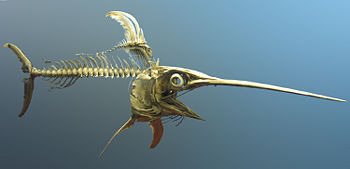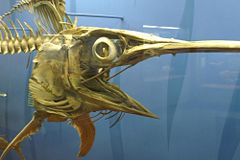What Kind Of Animal Is A Swordfish
| Swordfish | ||||||||||||||
|---|---|---|---|---|---|---|---|---|---|---|---|---|---|---|
 | ||||||||||||||
| | ||||||||||||||
| Data deficient (IUCN) [two] | ||||||||||||||
| Scientific classification | ||||||||||||||
| ||||||||||||||
| | ||||||||||||||
| Xiphias gladius Linnaeus, 1758 |
Swordfish is the common name for a large, highly migratory, predatory marine fish, Xiphias gladius , characterized by a long, flat bill, the lack of pelvic fins, and an absenteeism of scales and teeth in adults. They are the sole fellow member of their family unit Xiphiidae. They are found worldwide in oceans, including the Pacific, Atlantic, and Indian Oceans, generally with a latitudinal range between 45°S and sixty°Northward (Gardieff 2008).
In add-on to the role in marine food chains, swordfish are well known for recreational fishing and cuisine, and their beauty, grace, and behavior adds to the mystery and wonder of nature. However, there also are concerns nearly their conservation status, due to overfishing, and mercury contagion has led to warnings virtually overconsumption (EPA 2004). Campaigns to bring sensation to the plight of this species have led to some reduction in their availability and their popularity in cuisine (see conservation status).
Contents
- i Clarification
- one.1 Suborder and family placement and characteristics
- 1.2 Sailfish description
- two Behavior, feeding, and reproduction
- three Importance
- iii.ane Culinary employ
- 3.2 Recreational importance
- iii.iii Conservation status
- 4 Notes
- 5 References
- 6 Credits
Description
Suborder and family placement and characteristics
Swordfish are part of the suborder Scombroidei. The suborder includes species that likely are the fastest swimming fish in the world, including bluefin tuna, swordfish, and sailfish (Nelson 1994, p. 424). Other members of the suborder include barracudas, mackerels, and snake mackerels. Members of the suborder are characterized by an upper jaw that is non protrusible, with the premaxilla fixed (an accommodation to feeding on larger prey) (Nelson 1994, p. 424).
The various billfishes (sailfishes, swordfish, marlins, and spearfishes) are generally separated into ii families, the Xiphidae and Istiophoridae, with the swordfish (Xiphias gladius) the only extant member of Xiphiidae, and the other billfishes placed within three genera within Istiophoridae (ITIS 2004; Agbayani 2008a). The three genera placed in Istiophoridae are Istiophorus (sailfishes), Tetrapturus (spearfishes), and Makaira (marlins) (Nelson 1994; ITIS 2004).
In some classifications, swordfish are placed together with the sailfishes, marlins, and spearfishes in the family Xiphiidae (Nelson 1994). That is, all the fish known equally billfishes are placed together in this i family, with 4 extant genera with 12 species in the family. Nelson (1994) follows this procedure because "there is abundant evidence that the formerly recognized Xiphiidae and Istiophoridae are sister groups" and that as terminal groups in Scombroidei "they should be placed in the aforementioned family." Every bit a comprehensive billfish family, Nelson (1994) characterizes Xiphiidae by adults having an elongate, premaxillary bill (or rostum), every bit well as an inferior mouth, the dorsal fin start over the dorsum of the head, and the dorsal fin lacking any truthful spines and from 37 to 55 rays (Nelson 1994, p. 428). The billfishes as well lack finlets behind the dorsal and anal fins, take 2 anal rays, the pectoral fins are inserted low on the body, the pelvic fins are reduced (i spine and two rays or absent), and the gill membranes are gratis from the isthmus (Nelson 1994, p. 428).
A notable characteristic of the billfishes is the remarkable ability to practise a course of endothermy, a type of warm-bloodedness where an elevated body temperature is maintained through internal ways. Billfish exhibit a type of endothermy known as cranial endothermy whereby only the brain and eyes are warmed (Nelson 1994; Block et al. 1993). They remain "cold-blooded" (specifically poikilothermic) in that they do not maintain constant internal temperatures and the temperature often mirrors the ambient temperature. Merely by being able to raise the temperature of their brains and eyes, they can take faster centre movements when hunting, which is valued when diving deep into the sea where the water is very cold.
Sailfish clarification

Swordfish skeleton at the National Museum of Natural History, Washington, DC.
What distinguishes the swordfish in Xiphiidae from other billfishes in Istiophoridae is the swordfish'south lack of scales and teeth in the developed, the lack of pelvic fins, the presence of 26 vertebrae, and the shape of the nib, which is depressed (Nelson 1994). The other billfish (Istiophoridae) have scales and teeth in the adult, have elongate pelvic fins, have 24 vertebrae, and a rounded bill (Nelson 1994). Nearly prominent in the Istiophoridae is the dorsal fin, which has a very long base, which is sail-similar in some species, and is depressible into groove (Nelson 1994, p. 428). Swordfish take a relatively pocket-size dorsal fin.
The swordfish is named afterwards its sharp bill, resembling a sword (Latin gladius), which together with its streamlined physique allows it to cut through the h2o with smashing ease and agility. Contrary to belief, the "sword" is non used to spear prey, only rather it is used to stun prey past slashing back and along (Nelson 1994, p. 428). Mainly the swordfish relies on its great speed and agility in the water to catch its casualty. One possible defensive employ for the sword-like bill is for protection from its few natural predators. The shortfin mako shark is one of the rare body of water creatures big enough and fast enough to chase downwardly and kill an developed swordfish, but they do non always win, since sometimes in the struggle with a shark a swordfish can kill it by ramming it in the gills or belly.
Swordfish grow very large, reaching a maximum size of 177 inches (455 centimeters) and 1,400 pounds (650 kilograms) (Gardieff 2008). The International Game Fish Association'southward all-tackle line-fishing record for a swordfish is a ane,182 pound (536.fifteen kg) specimen taken off Chile in 1953. Female swordfish grow larger than males, with fish over 300 pounds (135 kilograms) more often than not being female (Gardieff 2008). Females mature at iv to five years of age in northwest Pacific while males mature starting time at about iii to four years.
While swordfish are cold-blooded animals, they have special organs next to their eyes to heat their eyes and also their brain (Hopkin 2005; Fritsches 2005). Temperatures of ten to 15 C° above the surrounding water temperature accept been measured (Fritsches 2005). The heating of the eyes greatly improves the vision, and subsequently improves their ability to catch prey. Out of the 25 000+ species of bony fish, only about 22 are known to have the ability to estrus selected body parts to a higher place the temperature of the surrounding water. These include the swordfish, marlin, and tuna.
Behavior, feeding, and reproduction
Swordfish are not schooling fish. They swim alone or in very loose aggregations, separated past equally much as ten meters from a neighboring swordfish. They are frequently plant basking at the surface, airing their first dorsal fin. Boaters study this to be a cute sight, as is the powerful jumping for which the species is known. This jumping, as well called breaching, is thought by some researchers to be an try to dislodge pests, such as remora or lampreys. It could as well be a way of surface feeding by stunning small-scale fish every bit they spring out of the water, making the fish more than easily captured for food.
Adult swordfish forage includes pelagic fish, including minor tuna, dorado, barracuda, flying fish, and mackerel, equally well equally benthic species of hake and rockfish. Squid are important when available. Swordfish feed daily, most often at night when they rise to surface and virtually-surface waters in search of smaller fish. They accept been observed moving through schools of fish, thrashing their swords to impale or stun their casualty and so quickly turning to eat their catch.
Adults swordfish accept few natural enemies, with the exception of large sharks and sperm and killer whales. While swordfish are thought to have few predators, juveniles are vulnerable to predation past large pelagic fish.
In warmer equatorial waters, spawning occurs years round, such equally in the Caribbean Sea, Gulf of United mexican states, and the Florida coast; in cooler regions it occurs in the leap and summertime (Gardieff 2008). Off the coast of Italy in the Mediterranean is the most recognized spawning site and there the elevation of spawning is in July and Baronial (Gardieff 2008). In the North Pacific, batch spawning occurs in water warmer than 24°C from March to July and year-round in the equatorial Pacific.
Estimates of the number of eggs carried by a female in their gonads varies from one 1000000 to 29 million eggs (Gardieff 2008). These eggs are buoyant and pelagic and measure 1.six to 1.8 millimeters in diameter (Gardieff 2008). The pelagic larva are nigh four millimeters long when they hatch and live nearly the surface (Gardieff 2008).
Importance

In addition to importance in marine food chains, swordfish provide culinary and recreational value. Commercially, swordfish were harvested by a diversity of methods at small scale until the global expansion of long-line fishing. Longline gear can exist targeted to a variety of fish, only bycatch remains a significant problem.
Culinary utilise

Swordfish is a particularly popular fish for cooking. Since swordfish are large animals, meat is usually sold as steaks, which are oftentimes grilled. The colour of the flesh varies past diet, with fish caught on the east coast of North America often existence rosier.
Still, at that place is business organization almost potential toxicity from high levels of methylmercury in swordfish (EPA 2004; FDA 2004). A 2004 advisory from the United States Food and Drug Administration (FDA) recommended that women who are pregnant or who may become pregnant and young children practise not eat swordfish (FDA 2004).
Recreational importance
Swordfish are vigorous, powerful fighters. Novice anglers often fault the swordfish for a sailfish, with which it shares a striking resemblance. Even so, in addition to the differences noted above, with the dorsal fin beingness particularly obvious to observers, the sailfishes are relatively weak and can be caught on light tackle. Experienced angles remark that pound for pound, the swordfish are perhaps the strongest fish in the body of water. When hooked or harpooned, they have been known to dive so apace that they have impaled their swords into the bounding main bottom up to their eyes. Although at that place are no reports of unprovoked attacks on humans, swordfish tin be very dangerous when harpooned. They take run their swords through the planking of small boats when injure.
Recreational swordfishing throughout the world, and particularly in South Florida, has gained tremendous popularity. With the ban on longlining forth parts of the eastern seashore, swordfish populations are showing signs of recovery. The recovery is far from complete and is not a fraction of what it was in the '70s when recreational swordfish was discovered off the coast of Due south Florida.
Conservation status
Swordfish is non listed as an endangered species. The 2007 IUCN Crimson List of Threatened Species lists the swordfish conservation status as "information scarce," with the last assessment in 1996 (Safina 1996).
In 1998, the Natural Resources Defence Council and SeaWeb hired Fenton Communications to conduct an advertising campaign to promote their exclamation that the swordfish population was in danger due to its popularity as a restaurant entree (FC 2008). The resulting "Requite Swordfish a Intermission" promotion was wildly successful, with 750 prominent US chefs agreeing to remove Due north Atlantic swordfish from their menus. The advertizement campaign was repeated by the national media in hundreds of print and circulate stories, as well equally extensive regional coverage. Information technology earned the Silver Anvil honour from the Public Relations Society of America also as Fourth dimension magazine'due south award for the top 5 environmental stories of 1998. Afterwards, the National Marine Fisheries Service proposed a swordfish protection plan that incorporated the campaign'southward policy suggestions. Then-President Clinton chosen for a ban on the sale and import of swordfish and in a landmark conclusion past the federal authorities, 132,670 foursquare miles of the Atlantic ocean were placed off-limits to angling equally recommended by the sponsors (FC 2008).
Notes
- ↑ J. Sepkoski, "A compendium of fossil marine animal genera," Bulletins of American Paleontology 364 (2002): 560. Retrieved May 22, 2008.
- ↑ C. Safina, "Xiphias gladius," 2007 IUCN Red List of Threatened Species. IUCN 2007 (based on 1996 assessment). Retrieved June 1, 2008.
References
ISBN links support NWE through referral fees
- Environmental Protection Agency (EPA), U.s.. 2004. What y'all need to know about mercury in fish and shellfish United States Environmental Protection Agency. Retrieved June one, 2008.
- Fenton Communications (FC). 2008. Saving the threatened North Atlantic swordfish Fenton Communication. Retrieved June 1, 2008.
- Food and Drug Assistants (FDA). What you need to know about mercury in fish and shellfish: 2004 EPA and FDA advice for women who might become significant, women who are pregnant, nursing mothers, young children Nutrient and Drug Administration. Retrieved June 1, 2008.
- Fritsches, K. A., R. W. Brill, and E. J. Warrant. 2005. Warm eyes provide superior vision in swordfishes Current Biology 15: 55−58.
- Gardieff, S. 2008. Swordfish Florida Museum of Natural History. Retrieved May 22, 2008.
- Hopkin, M. 2005. Swordfish heat their eyes for better vision Nature News. Retrieved June 1, 2008.
- Integrated Taxonomic Data Arrangement (ITIS). 2004a. Xiphiidae ITIS Taxonomic Serial No.: 172480. Retrieved June one, 2008.
- Integrated Taxonomic Information Arrangement (ITIS). 2004b. Istiophoridae ITIS Taxonomic Series No.: 172486. Retrieved June 1, 2008.
- Nelson, J. S. 1994. Fishes of the World, 3rd ed. New York: John Wiley & Sons. ISBN 0471547131.
- Safina, C. 1996. "Xiphias gladius," 2007 IUCN Scarlet List of Threatened Species. IUCN 2007. Retrieved June 1, 2008.
- Sepkoski, J. 2002. A compendium of fossil marine animal genera Bulletins of American Paleontology 364: 560. Retrieved May 22, 2008.
Credits
New World Encyclopedia writers and editors rewrote and completed the Wikipedia commodity in accord with New World Encyclopedia standards. This article abides past terms of the Creative Commons CC-past-sa three.0 License (CC-by-sa), which may be used and disseminated with proper attribution. Credit is due under the terms of this license that tin reference both the New Globe Encyclopedia contributors and the selfless volunteer contributors of the Wikimedia Foundation. To cite this article click here for a listing of acceptable citing formats.The history of earlier contributions by wikipedians is accessible to researchers here:
- Swordfish history
The history of this article since it was imported to New World Encyclopedia:
- History of "Swordfish"
Note: Some restrictions may apply to utilise of individual images which are separately licensed.
Source: https://www.newworldencyclopedia.org/entry/Swordfish
Posted by: sipesagat1982.blogspot.com

0 Response to "What Kind Of Animal Is A Swordfish"
Post a Comment